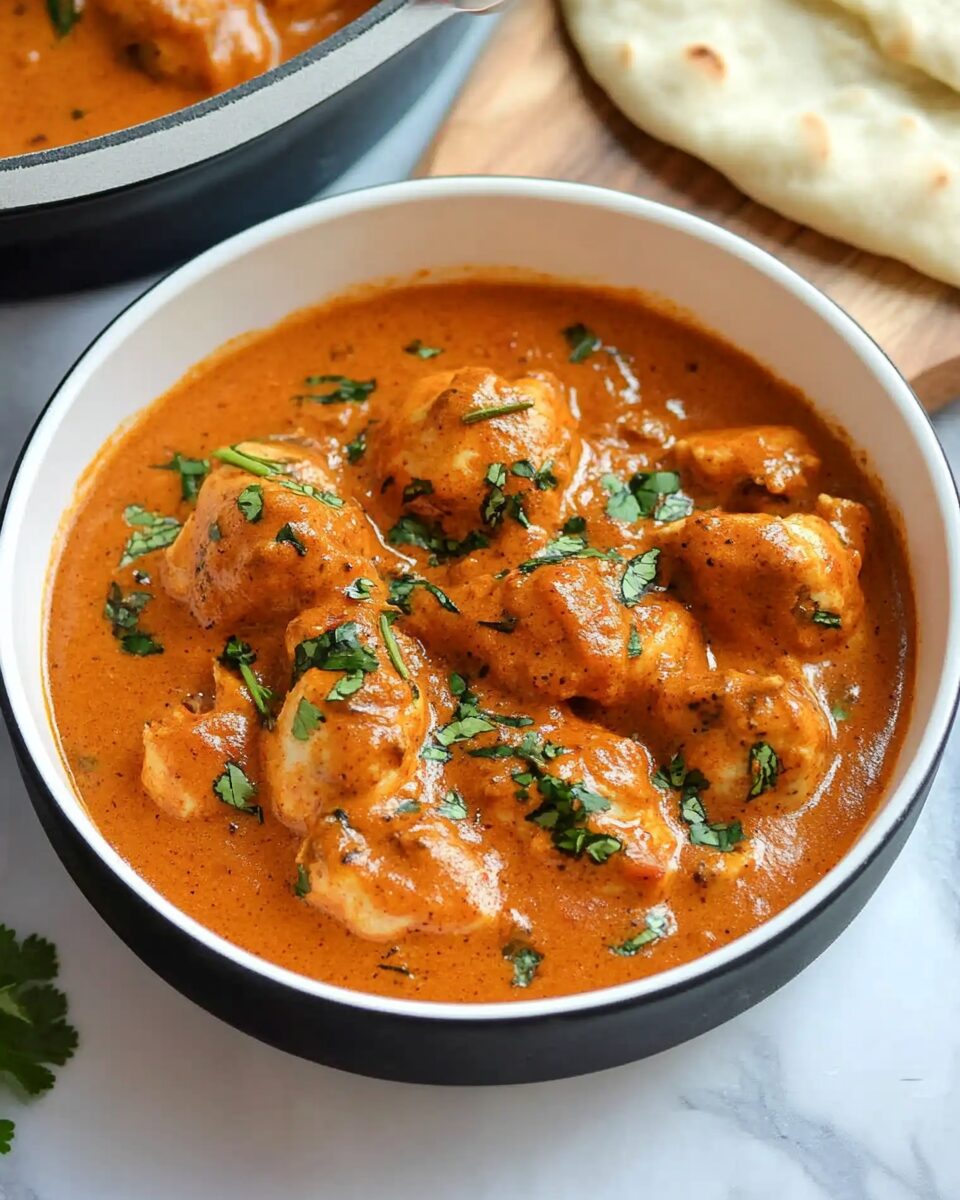Preparation and Cook Time
While Indian Butter Chicken may seem like an elaborate dish, its process is actually very manageable when broken into two key phases: marination and cooking. The chicken is first soaked in a quick lemon and chili powder marinade to tenderize and season, followed by a longer, deeper marinade in spiced yogurt that builds flavor and ensures the meat remains juicy and succulent when cooked. The actual cooking process—from sautéing aromatics to simmering the chicken in the tomato-cream sauce—takes about 30 minutes. Most of the hands-on time is concentrated in prepping and sautéing, while the sauce gently simmers to perfection. Planning ahead with the overnight marinade makes this a seamless, low-effort dish to assemble when you’re ready to cook.
Yield and Serving
This recipe yields approximately four generous servings, each filled with a hearty portion of chicken and sauce. It’s designed to be served alongside fluffy white rice or warm, soft naan bread—both of which act as the perfect vehicles for soaking up the rich, buttery sauce. Whether you’re cooking for a cozy weeknight family dinner or preparing a meal for guests, Butter Chicken makes an impressive and satisfying centerpiece. To stretch the meal for more people or balance the richness, pair it with sides like cucumber raita, a green salad, or roasted vegetables. Leftovers store well in the fridge for up to three days and can even taste better the next day as the flavors continue to meld.
Cuisine Type
Butter Chicken is rooted in North Indian cuisine, specifically Punjabi culinary traditions, and has since become one of India’s most globally recognized dishes. Originally developed in Delhi by chefs looking to use leftover tandoori chicken in a flavorful sauce, Chicken Makhani has evolved into a staple of Indian restaurants worldwide. The name “makhani” refers to the use of butter (makhan) and cream in the sauce, distinguishing it from spicier, more rustic Indian curries. This dish is a shining example of Mughlai influence in Indian cooking, known for its luxurious textures and aromatic profiles. The homemade version stays true to these traditions while offering a simplified, weeknight-friendly process.
Nutritional Information
Butter Chicken is undeniably rich, with each serving containing about 1245 calories. This includes 75 grams of fat, much of which comes from the butter, cream, and cashew butter that give the sauce its silky texture. The dish is also high in protein, delivering around 40 grams per serving, thanks to the chicken thighs. Carbohydrates primarily come from the tomato sauce base and the accompanying rice or naan, with about 104 grams total. Nutritional highlights include a high amount of Vitamin A from the tomato puree, calcium from the cream, and potassium from the spices and tomatoes. While it’s an indulgent meal, it provides a good balance of macronutrients and is deeply satisfying when enjoyed in moderation.
Origin and Popularity
Butter Chicken was invented in the 1950s at the legendary Moti Mahal restaurant in Delhi, where leftover tandoori chicken was repurposed in a rich tomato-butter sauce. Since then, it has grown into a symbol of Indian hospitality and culinary excellence. It’s now a staple on Indian restaurant menus across the world, particularly in the UK, North America, and Australia. Its popularity stems from its well-balanced flavor profile that is both accessible and deeply satisfying. Unlike some spicier Indian curries, Butter Chicken is milder, creamier, and appeals to a broader audience, making it a perfect introductory dish for those new to Indian cuisine. The use of garam masala, fenugreek, and cardamom gives it that unmistakable Indian depth, while the buttery tomato base makes it comfort food at its finest.
Why You’ll Love This Dish
There are countless reasons to love Indian Butter Chicken. The chicken itself is incredibly tender thanks to the two-stage marinade, absorbing the rich blend of spices and yogurt that keep it juicy during cooking. The sauce is the real showstopper—lush, buttery, and complex, with just enough spice to warm your palate without overwhelming it. The addition of cashew butter provides a natural creaminess and slight sweetness that balances the acidity of the tomato puree, while garam masala and dried fenugreek leaves give it a signature depth. It’s a dish that feels indulgent yet comforting, luxurious yet simple to make. It works equally well for a celebratory meal or a cozy night in, and once you’ve made it from scratch, you may never order takeout again.
Health Benefits
Despite its indulgent nature, Butter Chicken offers a variety of healthful components. The chicken provides lean protein essential for muscle maintenance and satiety. Spices like turmeric, ginger, garlic, and chili powder are anti-inflammatory and packed with antioxidants. Fenugreek, a key ingredient in the marinade and sauce, has long been used in traditional medicine for its benefits in digestion and blood sugar regulation. Tomatoes are a great source of lycopene, an antioxidant linked to heart health, while cashew butter adds healthy fats and magnesium. To make the dish even more health-conscious, you can substitute some of the butter or cream with Greek yogurt, use skinless chicken breast, or serve it with brown rice for added fiber.
Serving Suggestions
Butter Chicken is best enjoyed with basmati rice or naan bread—both of which act as the perfect canvas for the rich, aromatic sauce. For a more balanced plate, serve it alongside a cooling cucumber raita, a tangy tomato and onion salad, or a lightly dressed green salad. If you want to add variety to the meal, consider offering a side of aloo gobi (potato and cauliflower curry), sautéed spinach with garlic, or crispy papadum. For drinks, a light Indian lager or a glass of chilled Riesling pairs well with the creamy heat of the curry. Garnish your finished dish with a drizzle of cream and a few fresh cilantro leaves for added flavor and a polished presentation.
Tips for Success
To achieve restaurant-style results, be generous with the marination time. The longer the chicken sits in the yogurt-spice mixture, the more flavorful and tender it becomes. Searing the chicken before simmering in the sauce helps lock in moisture and adds depth. Don’t rush the sauce—allowing the butter, spices, and tomato puree to cook slowly creates a rich base with maximum flavor. Cashew butter or ground soaked cashews provide creaminess without diluting the flavor, and heavy cream brings the dish to its signature finish. If the sauce becomes too thick, thin it out with a splash of water or additional cream. Be sure to taste and adjust seasoning at the end—sometimes a little extra sugar or salt is all it takes to perfect the flavor balance.
Variations
Butter Chicken is incredibly versatile. For a lighter version, use low-fat cream or even coconut milk for a dairy-free take that still offers creamy texture. Vegetarians can substitute paneer or roasted cauliflower for chicken, maintaining all the richness of the sauce. If you enjoy more heat, add additional green chili or a touch of cayenne pepper. For a smokier flavor, grill or broil the marinated chicken before adding it to the sauce. You can also make this dish ahead of time and store it in the fridge for up to three days—the flavors only deepen with time. It’s freezer-friendly too, making it a great choice for batch cooking and meal prep.
Conclusion
Indian Butter Chicken is more than just a dish—it’s a cultural icon that brings warmth, flavor, and joy to any table. With its irresistibly creamy tomato-based curry, aromatic spices, and tender, marinated chicken, it’s no wonder this dish has earned global admiration. This homemade version honors its origins while offering a simplified process that makes it accessible for everyday cooks. Whether you’re new to Indian cuisine or a seasoned fan, Butter Chicken promises a deeply satisfying experience in every bite. Serve it with rice or naan, share it with loved ones, and savor the kind of meal that feels like a warm embrace—rich, flavorful, and made from the heart.






